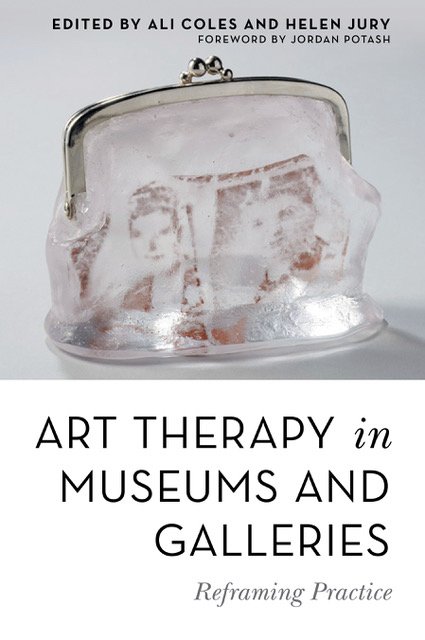Coles, A & Jury, H. (Eds.) (2020) Art therapy in museums and art galleries: reframing practice. London & Philadelphia: Jessica Kingsley.

I have always loved visiting museums and art galleries - often described as the ‘cathedrals’ of the art world - and I think this is the same for many artists and art therapists. I look forward to the feelings of awe, wonder, and interest I get when I encounter great pieces of work and know that I will come out with a renewed sense of creativity, inspiration and imagination, feeding the drive to make art myself. It makes sense therefore to offer this experience to our clients, many of whom have never set foot in an art gallery before. In the Forward Jordan Potash talks of regularly visiting, and drawing inspiration from the Washington National Gallery of Art’s many exhibits and exhibitions, and focuses on the way spaces within museums and art galleries can be revisioned and reinvigorated by art therapists – from leisurely, educational or scholarly spaces – into therapeutic spaces that promote and seek to ameliorate health and social issues.
This fascinating book showcases a collection of chapters written by art therapists throughout the world who have pushed the boundaries of what art therapy and art therapy spaces can be.
Therefore, the main focus is the valuable art therapy practice and research being carried out within national and international museums and art galleries, highlighting the increase in collaboration between art therapists and the museums sector. Recent years have seen a national campaign to increase community engagement, with a focus on increasing equality, diversity, inclusivity and accessibility within the museums and art gallery sectors. The inclusion of art therapy programmes and spaces goes a long way in helping museums and art galleries to achieve this aim.
For clients attending art therapy within these unique spaces, it is a chance for them to become acquainted with historic, meaningful and inspiring objects and works of art. More importantly it provides a safe space free of stigma or clinicalisation, something that can be as debilitating as the issues they face. This book therefore provides important insight into the work being carried out in the field, offering inspiration to art therapists and other mental health professionals to develop projects in their local museums and art galleries, with a focus on their own area of art therapy expertise.
The book is usefully divided into 3 sections, with section 1 exploring the context of art therapy practice within museums and art galleries. Sue Holttum presents a thorough review of the key literature published in this field over the past 20 years highlighting the results indicated and the methodologies used. This is a great resource for any art therapist considering carrying out research in this area. Holttum also outlines the gaps in knowledge in this field and how these can be filled by art therapists using specific research methods.
Ali Coles continues to build the contextual and background knowledge within the field by discussing research undertaken within the UK that explores the relationship between the general public and museums and art galleries. Coles also explores how views commonly held by clients may influence their engagement in art therapy in this setting, and understanding that the term ‘museum’ may evoke issues and concepts such as exclusivity, power and wealth, in clients’ minds. However, Coles concludes that many perceptions held by adults in the UK concur with those held by art therapists working in the field, that museums and art galleries can be accessible and inclusive places for learning and play, as well as contained, held therapeutic spaces that allow trust, creativity, self-knowledge and acceptance to develop.
The very important subject of making space safe within the museum and art gallery is discussed by Mary Chamberlain, using her experience of facilitating a therapeutic art group at the Museum of Modern Art in Oxford (UK), to highlight the issues and benefits involved. Chamberlain explores how a museum’s preoccupation with the safety and containment of objects (even those which are broken or incomplete) and their meaning, can help clients feel that they themselves and their creative output will be similarly valued within the therapeutic group.
Sections 2 and 3 contain a collection of reflective and well written chapters highlighting the unlimited potential of museums and art galleries as inspirational, creative and safe spaces for art therapy collaborations and services. As well as safely supporting clients to explore personal issues, the overriding themes within these chapters include e.g.: storytelling, developing cultural access and a sense of belonging through visiting the museum, exploring and developing identity, multi-sensory experience, developing creativity and feelings of self-worth, viewing inspirational art, collaborations with curators, using historical objects to connect to the present, and clients exhibiting work at museums and art galleries. With art therapists from as far afield as Russia and Montreal, this book provides a unique selection of the many collaborations with museum and art galleries being developed throughout the world.
Helen Jury examines how viewing artworks in a gallery space (using the example of Rembrandt’s self-portraits exhibited at the National Gallery), can inform our understanding of art psychotherapy practice. Although working with collections within museums and art galleries is seen as innovative, in a way it is a return to the early beginnings of art therapy, when Adrian Hill (1895 – 1977) one of the first pioneers of Art Therapy in this country, began his work with patients in sanitoriums by facilitating ‘magic lantern lectures’ of famous works of art (Hill, 1945, p.44). Hill also built up a collection of postcards featuring works of art from museums and art galleries to distribute to the patient’s bedside (ibid. p.46), and as such was bringing the museum and art gallery into the hospital, directly to the patient! However beneficial this is, there is something about being there, and viewing the art object directly, that this volume examines and celebrates.
If I have any criticism it is that there is no concluding chapter written by the two editors, bringing together all the diverse elements presented within the book, highlighting the important learning gained from each contributing chapter, and offering a sense of direction for the future, both for research and practice in this exciting field. Nonetheless, I highly recommend this book to art therapists, art psychotherapists, arts in health practitioners, museum professionals, and all those who believe in the power of art to inspire, challenge and heal. Art Therapy in Museums and Art Galleries is the first book to comprehensively explore this exciting practice, and therefore makes an important contribution to this developing field, it is available to purchase for £26.99 from Jessica Kingsley Publishers https://www.jkp.com/uk/art-therapy-in-museums-and-galleries-40298.html. Remember that BAAT members can get a 30% discount by adding the code BAAT30 to their order from Jessica Kingsley online!
Organisations such as the Culture, Health and Wellbeing Alliance, also offer useful resources for art therapists, with their website containing further case studies, research, funding avenues and toolkits. Any art therapist registered with BAAT and interested in this area of work, can also join the BAAT Museum and Gallery Special Interest Group (MAGSIG) available on https://baatforums.org. The MAGSIG also has their own informative website http://www.atmag.org/
References
Coles, A & Jury, H. (Eds.) (2020) Art Therapy in Museums and Art Galleries: Reframing Practice. London & Philadelphia: Jessica Kingsley.
Hill, A. (1945) Art Versus Illness: A Story of Art Therapy. London: George Allen and Unwin Ltd.
Copyright (c) The British Association of Art Therapists (BAAT)
This article is published in BAAT Newsbriefing Summer 2020 and may not be distributed or published without the consent of BAAT

